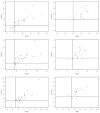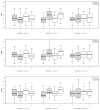Evaluation of Multi-Frequency Bioelectrical Impedance Analysis against Dual-Energy X-ray Absorptiometry for Estimation of Low Muscle Mass in Older Hospitalized Patients
- PMID: 38202202
- PMCID: PMC10779600
- DOI: 10.3390/jcm13010196
Evaluation of Multi-Frequency Bioelectrical Impedance Analysis against Dual-Energy X-ray Absorptiometry for Estimation of Low Muscle Mass in Older Hospitalized Patients
Abstract
The accuracy of multi-frequency (MF) bioelectrical impedance analysis (BIA) to estimate low muscle mass in older hospitalized patients remains unclear. This study aimed to describe the ability of MF-BIA to identify low muscle mass as proposed by The Global Leadership Initiative on Malnutrition (GLIM) and The European Working Group on Sarcopenia in Older People (EWGSOP-2) and examine the association between muscle mass, dehydration, malnutrition, and poor appetite in older hospitalized patients. In this prospective exploratory cohort study, low muscle mass was estimated with MF-BIA against dual-energy X-ray absorptiometry (DXA) in 42 older hospitalized adults (≥65 years). The primary variable for muscle mass was appendicular skeletal muscle mass (ASM), and secondary variables were appendicular skeletal muscle mass index (ASMI) and fat-free mass index (FFMI). Cut-off values for low muscle mass were based on recommendations by GLIM and EWGSOP-2. MF-BIA was evaluated against DXA on the ability to estimate absolute values of muscle mass by mean bias, limits of agreement (LOA), and accuracy (5% and 10% levels). Agreement between MF-BIA and DXA to identify low muscle mass was evaluated with sensitivity, specificity, negative predictive value (NPV), and positive predictive value (PPV). The association between muscle mass, dehydration, malnutrition, and poor appetite was visually examined with boxplots. MF-BIA overestimated absolute values of ASM with a mean bias of 0.63 kg (CI: -0.20:1.46, LOA: -4.61:5.87). Agreement between MF-BIA and DXA measures of ASM showed a sensitivity of 86%, specificity of 94%, PPV of 75% and NPV of 97%. Boxplots indicate that ASM is lower in patients with malnutrition. This was not observed in patients with poor appetite. We observed a tendency toward higher ASM in patients with dehydration. Estimation of absolute ASM values with MF-BIA should be interpreted with caution, but MF-BIA might identify low muscle mass in older hospitalized patients.
Keywords: BIA; DXA; malnutrition; muscle mass; older patients; sarcopenia.
Conflict of interest statement
The authors report no potential conflicts of interest in relation to this study.
Figures




Similar articles
-
Accuracy of surrogate methods to estimate skeletal muscle mass in non-dialysis dependent patients with chronic kidney disease and in kidney transplant recipients.Clin Nutr. 2021 Jan;40(1):303-312. doi: 10.1016/j.clnu.2020.05.021. Epub 2020 May 26. Clin Nutr. 2021. PMID: 32536581
-
Fat-Free Mass Index as a Surrogate Marker of Appendicular Skeletal Muscle Mass Index for Low Muscle Mass Screening in Sarcopenia.J Am Med Dir Assoc. 2022 Dec;23(12):1955-1961.e3. doi: 10.1016/j.jamda.2022.08.016. Epub 2022 Sep 28. J Am Med Dir Assoc. 2022. PMID: 36179769
-
Comparison between bioelectrical impedance analyses and dual-energy X-ray absorptiometry for accuracy in assessing appendicular skeletal muscle mass and diagnosing sarcopenia in hospitalized Chinese older adults.Medicine (Baltimore). 2023 Sep 29;102(39):e35250. doi: 10.1097/MD.0000000000035250. Medicine (Baltimore). 2023. PMID: 37773822 Free PMC article.
-
Comparison of bioelectrical impedance analysis and dual-energy X-ray absorptiometry for the diagnosis of sarcopenia in the older adults with metabolic syndrome: equipment-specific equation development.Aging Clin Exp Res. 2024 Dec 27;37(1):12. doi: 10.1007/s40520-024-02898-1. Aging Clin Exp Res. 2024. PMID: 39725814 Free PMC article. Review.
-
A Comprehensive Review of the Correlations of Measurement Parameters among Modern Technologies for Sarcopenia Assessment.Aging Dis. 2025 May 22. doi: 10.14336/AD.2025.0145. Online ahead of print. Aging Dis. 2025. PMID: 40479576 Review.
Cited by
-
Perioperative management of sarcopenia in patients undergoing major surgeries in Singapore: a modified Delphi consensus.Int J Surg. 2024 Aug 1;110(8):4552-4558. doi: 10.1097/JS9.0000000000001515. Int J Surg. 2024. PMID: 38701514 Free PMC article.
-
Advancing the Understanding of Malnutrition in the Elderly Population: Current Insights and Future Directions.Nutrients. 2024 Jul 31;16(15):2502. doi: 10.3390/nu16152502. Nutrients. 2024. PMID: 39125381 Free PMC article. Review.
-
Prevalence, Impact, and Screening Methods of Sarcopenia in Japanese Patients With Parkinson's Disease: A Prospective Cross-Sectional Study.Cureus. 2024 Jul 24;16(7):e65316. doi: 10.7759/cureus.65316. eCollection 2024 Jul. Cureus. 2024. PMID: 39184585 Free PMC article.
References
-
- Cederholm T., Jensen G.L., Correia M.I.T.D., Gonzalez M.C., Fukushima R., Higashiguchi T., Baptista G., Barazzoni R., Blaauw R., Coats A., et al. GLIM Criteria for the Diagnosis of Malnutrition—A Consensus Report from the Global Clinical Nutrition Community. Clin. Nutr. 2019;38:1–9. doi: 10.1016/j.clnu.2018.08.002. - DOI - PubMed
-
- Martone A.M., Bianchi L., Abete P., Bellelli G., Bo M., Cherubini A., Corica F., Di Bari M., Maggio M., Manca G.M., et al. The Incidence of Sarcopenia among Hospitalized Older Patients: Results from the Glisten Study. J. Cachexia Sarcopenia Muscle. 2017;8:907–914. doi: 10.1002/jcsm.12224. - DOI - PMC - PubMed
-
- Andersen A.L., Nielsen R.L., Houlind M.B., Tavenier J., Rasmussen L.J.H., Jørgensen L.M., Treldal C., Beck A.M., Pedersen M.M., Andersen O., et al. Risk of Malnutrition upon Admission and after Discharge in Acutely Admitted Older Medical Patients: A Prospective Observational Study. Nutrients. 2021;13:2757. doi: 10.3390/nu13082757. - DOI - PMC - PubMed
Grants and funding
LinkOut - more resources
Full Text Sources

